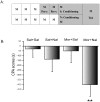Effects of exogenous cholecystokinin octapeptide on acquisition of naloxone precipitated withdrawal induced conditioned place aversion in rats
- PMID: 22848639
- PMCID: PMC3407117
- DOI: 10.1371/journal.pone.0041860
Effects of exogenous cholecystokinin octapeptide on acquisition of naloxone precipitated withdrawal induced conditioned place aversion in rats
Abstract
Cholecystokinin octapeptide (CCK-8), a gut-brain peptide, regulates a variety of physiological behavioral processes. Previously, we reported that exogenous CCK-8 attenuated morphine-induced conditioned place preference, but the possible effects of CCK-8 on aversively motivated drug seeking remained unclear. To investigate the effects of endogenous and exogenous CCK on negative components of morphine withdrawal, we evaluated the effects of CCK receptor antagonists and CCK-8 on the naloxone-precipitated withdrawal-induced conditioned place aversion (CPA). The results showed that CCK2 receptor antagonist (LY-288,513, 10 µg, i.c.v.), but not CCK1 receptor antagonist (L-364,718, 10 µg, i.c.v.), inhibited the acquisition of CPA when given prior to naloxone (0.3 mg/kg) administration in morphine-dependent rats. Similarly, CCK-8 (0.1-1 µg, i.c.v.) significantly attenuated naloxone-precipitated withdrawal-induced CPA, and this inhibitory function was blocked by co-injection with L-364,718. Microinjection of L-364,718, LY-288,513 or CCK-8 to saline pretreated rats produced neither a conditioned preference nor aversion, and the induction of CPA by CCK-8 itself after morphine pretreatments was not significant. Our study identifies a different role of CCK1 and CCK2 receptors in negative affective components of morphine abstinence and an inhibitory effect of exogenous CCK-8 on naloxone-precipitated withdrawal-induced CPA via CCK1 receptor.
Conflict of interest statement
Figures




Similar articles
-
Cholecystokinin octapeptide induces endogenous opioid-dependent anxiolytic effects in morphine-withdrawal rats.Neuroscience. 2014 Sep 26;277:14-25. doi: 10.1016/j.neuroscience.2014.06.048. Epub 2014 Jun 30. Neuroscience. 2014. PMID: 24993476
-
Cholecystokinin receptor-1 mediates the inhibitory effects of exogenous cholecystokinin octapeptide on cellular morphine dependence.BMC Neurosci. 2012 Jun 8;13:63. doi: 10.1186/1471-2202-13-63. BMC Neurosci. 2012. PMID: 22682150 Free PMC article.
-
Cholecystokinin receptor agonists block the jumping behaviour precipitated in morphine-dependent mice by naloxone.Eur Neuropsychopharmacol. 1999 Jan;9(1-2):37-43. doi: 10.1016/s0924-977x(97)00104-1. Eur Neuropsychopharmacol. 1999. PMID: 10082226
-
Involvement of glutamate receptors within the central nucleus of the amygdala in naloxone-precipitated morphine withdrawal-induced conditioned place aversion in rats.Jpn J Pharmacol. 2002 Apr;88(4):399-406. doi: 10.1254/jjp.88.399. Jpn J Pharmacol. 2002. PMID: 12046982
-
[Involvement of the amygdala on place aversion induced by naloxone in single-dose morphine-treated rats].Yakugaku Zasshi. 2008 Mar;128(3):395-403. doi: 10.1248/yakushi.128.395. Yakugaku Zasshi. 2008. PMID: 18311059 Review. Japanese.
Cited by
-
Cholecystokinin neurotransmission in the central nervous system: Insights into its role in health and disease.Biofactors. 2024 Nov-Dec;50(6):1060-1075. doi: 10.1002/biof.2081. Epub 2024 May 22. Biofactors. 2024. PMID: 38777339 Free PMC article. Review.
-
Neural circuit mechanisms of the cholecystokinin (CCK) neuropeptide system in addiction.Addict Neurosci. 2022 Sep;3:100024. doi: 10.1016/j.addicn.2022.100024. Epub 2022 Jun 17. Addict Neurosci. 2022. PMID: 35983578 Free PMC article.
References
-
- Carlezon WA Jr (2003) Place conditioning to study drug reward and aversion. Methods Mol Med 84: 243–249. - PubMed
-
- Moran TH, Schwartz GJ (1994) Neurobiology of cholecystokinin. Crit Rev Neurobiol 9(1): 1–28. - PubMed
-
- Faris PL, Komisaruk BR, Watkins LR, Mayer DJ (1983) Evidence for the neuropeptide cholecystokinin as an antagonist of opiate analgesia. Science 219: 310–312. - PubMed
-
- Runkorg K, Veraksits A, Kurrikoff K, Luuk H, Raud S, et al. (2003) Distinct changes in the behavioural effects of morphine and naloxone in CCK2 receptor-deficient mice. Behav Brain Res 144 1–2: 125–135. - PubMed
Publication types
MeSH terms
Substances
LinkOut - more resources
Full Text Sources
Other Literature Sources

